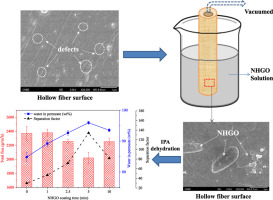当前位置:
X-MOL 学术
›
J. Membr. Sci.
›
论文详情
Our official English website, www.x-mol.net, welcomes your feedback! (Note: you will need to create a separate account there.)
Two-dimensional (2D) particle coating on membranes for pervaporation dehydration of isopropanol: a new approach to seal defects and enhance separation performance
Journal of Membrane Science ( IF 9.5 ) Pub Date : 2017-12-01 , DOI: 10.1016/j.memsci.2017.09.038 Peyman Salehian , Tai-Shung Chung
Journal of Membrane Science ( IF 9.5 ) Pub Date : 2017-12-01 , DOI: 10.1016/j.memsci.2017.09.038 Peyman Salehian , Tai-Shung Chung

|
Abstract The aim of this work is to introduce a new post modification method for polymeric hollow fiber membranes with much-enhanced separation performance for pervaporation dehydration of isopropanol. An ultrathin two-dimensional (2D) ammonia functionalized graphene oxide (NHGO) was vacuum deposited on the shell side of P84 hollow fibers to seal defects without much increasing the overall mass transport resistance. The separation factor of the treated fibers in NHGO solutions for 5 min increased by more than 4 times with a small flux reduction compared to the original fibers. In addition, annealing fibers at low temperatures after the 2D modification further improved separation factor and increased fibers’ long-term stability. For example, a P84 fiber treated for 5 min in NHGO and then annealed at 100 °C exhibited excellent performance. It had a flux of 1914 g m−2 h−1 and a water purity of 99.1% (i.e., a separation factor of 624). These superior properties may arise from three factors: (1) the simultaneous amidation reaction between the polymer matrix and the 2D particles effectively sealed the membrane defects and covalently bonded 2D particles on the surface; (2) the densification of the selective layer during annealing not only increased its selectivity but also reduced membrane swelling; and (3) the partial reduction of certain functional groups of the 2D particles during annealing regulated the pathway for water transport and produced a balanced membrane structure.
中文翻译:

用于异丙醇渗透蒸发脱水的二维 (2D) 颗粒涂层:一种密封缺陷和提高分离性能的新方法
摘要 本工作的目的是介绍一种新的聚合物中空纤维膜后改性方法,该方法大大提高了异丙醇渗透蒸发脱水的分离性能。将超薄二维 (2D) 氨功能化氧化石墨烯 (NHGO) 真空沉积在 P84 中空纤维的壳侧以密封缺陷,而不会显着增加整体传质阻力。与原始纤维相比,处理过的纤维在 NHGO 溶液中 5 分钟的分离因子增加了 4 倍以上,但通量降低很小。此外,二维改性后的纤维在低温下退火进一步提高了分离系数并增加了纤维的长期稳定性。例如,在 NHGO 中处理 5 分钟然后在 100 °C 下退火的 P84 纤维表现出优异的性能。它的通量为 1914 g m-2 h-1,水纯度为 99.1%(即分离因子为 624)。这些优异的性能可能源于三个因素:(1) 聚合物基体和二维颗粒之间同时进行的酰胺化反应有效地密封了膜缺陷和表面共价键合的二维颗粒;(2) 退火过程中选择性层的致密化不仅增加了其选择性,而且减少了膜膨胀;(3) 退火过程中二维粒子某些官能团的部分还原调节了水的传输途径并产生了平衡的膜结构。(1)聚合物基体与二维粒子同时发生酰胺化反应,有效封闭了膜缺陷,使二维粒子共价键合在表面;(2) 退火过程中选择性层的致密化不仅增加了其选择性,而且减少了膜膨胀;(3) 退火过程中二维粒子某些官能团的部分还原调节了水的传输途径并产生了平衡的膜结构。(1)聚合物基体与二维粒子同时发生酰胺化反应,有效封闭了膜缺陷,使二维粒子共价键合在表面;(2) 退火过程中选择性层的致密化不仅增加了其选择性,而且减少了膜膨胀;(3) 退火过程中二维粒子某些官能团的部分还原调节了水的传输途径并产生了平衡的膜结构。
更新日期:2017-12-01
中文翻译:

用于异丙醇渗透蒸发脱水的二维 (2D) 颗粒涂层:一种密封缺陷和提高分离性能的新方法
摘要 本工作的目的是介绍一种新的聚合物中空纤维膜后改性方法,该方法大大提高了异丙醇渗透蒸发脱水的分离性能。将超薄二维 (2D) 氨功能化氧化石墨烯 (NHGO) 真空沉积在 P84 中空纤维的壳侧以密封缺陷,而不会显着增加整体传质阻力。与原始纤维相比,处理过的纤维在 NHGO 溶液中 5 分钟的分离因子增加了 4 倍以上,但通量降低很小。此外,二维改性后的纤维在低温下退火进一步提高了分离系数并增加了纤维的长期稳定性。例如,在 NHGO 中处理 5 分钟然后在 100 °C 下退火的 P84 纤维表现出优异的性能。它的通量为 1914 g m-2 h-1,水纯度为 99.1%(即分离因子为 624)。这些优异的性能可能源于三个因素:(1) 聚合物基体和二维颗粒之间同时进行的酰胺化反应有效地密封了膜缺陷和表面共价键合的二维颗粒;(2) 退火过程中选择性层的致密化不仅增加了其选择性,而且减少了膜膨胀;(3) 退火过程中二维粒子某些官能团的部分还原调节了水的传输途径并产生了平衡的膜结构。(1)聚合物基体与二维粒子同时发生酰胺化反应,有效封闭了膜缺陷,使二维粒子共价键合在表面;(2) 退火过程中选择性层的致密化不仅增加了其选择性,而且减少了膜膨胀;(3) 退火过程中二维粒子某些官能团的部分还原调节了水的传输途径并产生了平衡的膜结构。(1)聚合物基体与二维粒子同时发生酰胺化反应,有效封闭了膜缺陷,使二维粒子共价键合在表面;(2) 退火过程中选择性层的致密化不仅增加了其选择性,而且减少了膜膨胀;(3) 退火过程中二维粒子某些官能团的部分还原调节了水的传输途径并产生了平衡的膜结构。



























 京公网安备 11010802027423号
京公网安备 11010802027423号